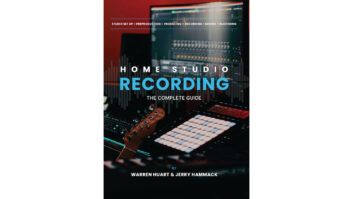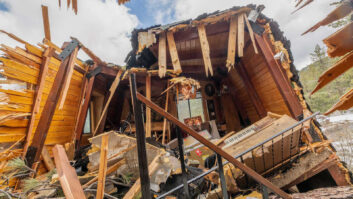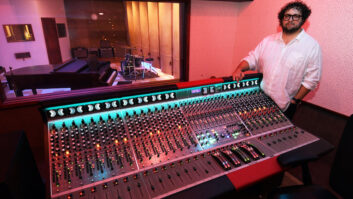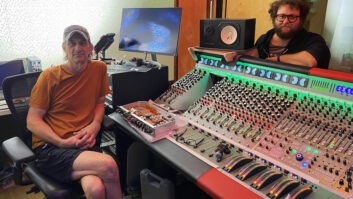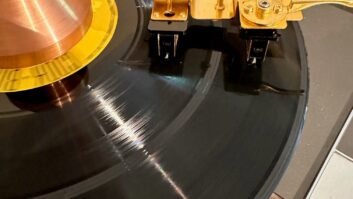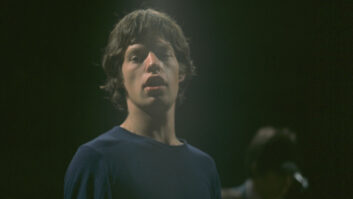Following is a guide to the top-of-the line offerings from various makers of disk-based recorders-emphasis on recorders. This is not intended to be a roundup of digital audio workstations; there are hundreds of DAWs available, from simple sound cards to elaborate proprietary systems that offer recording, editing and mixing functions in one comprehensive package. We narrowed this selection down to units designed to be “single-box” recording solutions. Systems that require a separate computer or monitor interface, offering more workstation functionality, such as the SADiE Octavia, Fairlight MFX3 and AMS Neve AudioFile, are outside the scope of this article. (However, we will be covering these and other workstations in an upcoming issue.) Meanwhile, we’ve limited this list to standalone machines offering at least eight tracks of nonlinear recording (leaving out 4-channel units, such as the Zaxcom Deva, and 360 Systems’ 2-channel Shortcut; and tape-based systems, such as the Nagra decks, the Alesis ADAT and the Tascam DA-88). Lastly, we’ve omitted playback-only units such as Fairlight’s Digital Audio Dubber. This is not meant to be a complete listing-there are a wide variety of machines to choose from; we encourage you to research all available platforms and configurations to find a solution that’s ideal for your needs.
The latest in Akai’s DR series of stand-alone hard disk recorders, the DR16 Plus is a 16-channel, 24-bit/ 96kHz-capable recording system housed in a rackmount chassis. Editing features include nondestructive copy, repeat, move and insert functions; 109 autolocate points; and a Take function that can store up to five trial recordings on one track for easy auditioning of a performance. The 16-channel mixer offers 99-scene snapshot automation, fully dynamic automation via MIDI, two aux sends and a stereo bus for internal mixdown. The DR16 Plus’ standard SCSI interface allows for connection of external drives including MO and Jaz drives; up to seven SCSI devices can be connected. In addition, multiple units can be linked for up to 128 available tracks. Options include SCSI-B and MIDI interfaces, SMPTE read/write capability, RS-422 interface, ADAT I/O support, 24-bit/96kHz AES/EBU digital I/O, and a 16-channel digital EQ board. Also available is the MT8 remote mixer controller, offering real-time control of the DR16 Plus’ mixer functions via dedicated sliders, panpots and track select switches. Individual control of up to eight DR16s and/or DR8s in any combination, plus dedicated controls for two send levels, and optional EQ8 and EQ16 parametric EQ boards, are included. The DR16 Plus will be available in July at a suggested retail price of $3,995.
The OMX 24/48 MkII-the latest generation of optical disk recorders from Augan-offers up to 48 tracks with 48 analog and digital inputs/outputs. It is capable of recording 24-bit data, has 24-bit A/D converters, and features nondestructive editing with virtually instant waveform display, with track arming, input repro switching for all 24/48 tracks, real transport controls and an ergonomic editing layout. Real-time DSP functions include 4-band parametric equalization (segment based), time compression/expansion and pitch shifting, varispeed and sample rate conversion. Other features include CMX auto-conform and reconforming, constant sample rate output during jog/shuttle or off-speed playback. Full synchronization capabilities include RS-422, parallel, timecode, bi-phase, VITC, Word Clock, and gen lock. The OMX 24/48 also offers film dubber emulation with up to double-speed forward and reverse- locked to timecode or bi-phase. Other features include parallel or serial track arming for all 24 tracks, feet/frame operation and support for all timecode formats and frame rates. An available dedicated remote control can simultaneously control and edit on up to 48 systems.
Now distributed by Studer, Digital Audio Research’s SAM (Scalable Audio Multitrack) is an 8-track digital dubber/recorder that can be configured and expanded for any number of tracks between eight and 1,024, in blocks of eight tracks, with a scalable architecture that provides centralized control and editing as a single virtual machine. Features include segment- and region-based editing functions, 9-pin RS-422 protocol support and user-adjustable threshold record. SAM is based on three-rackspace modules, each with onboard 24-bit DACs and ADCs, with options available for eight channels of AES/EBU I/O and a wide range of storage media, including removable hard drives, MO disks and Jaz drives. Audio is stored as .WAV files, compatible with the current OMFI spec, and support is planned for the upcoming AAF and AES 31 specs. Recording resolution can be set for 16/20/24 bits, with sampling up to 192 kHz; looping, full-bandwidth scrubbing and forward/backward lock to biphase or timecode should all appeal to the post user. Pricing is about $9,000.
The Euphonix R-1 is a multitrack recorder with 24-track, 24/96 capability, featuring 24-bit conversion and 40-bit floating-point internal DSP (four Analog Devices SHARC processors). The system has a rackmount CPU and storage/backup units, plus a remote control interface (with MADI interface), and is designed to emulate a traditional analog tape recorder with a familiar tape-style remote. Standard features include MADI digital I/O, constant-sample-rate vari-speed, serial machine control, sample/ timecode synchronization, reverse play, jog, shuttle and modular hardware. The R-1 is expandable, with an open architecture supporting future I/O options, sample rates, machine control, track expansion, editing and networking. Premium quality 24-bit A/D and D/A converters are optional. (Price, $25,000 for 24 tracks, converters extra.)
Fostex’s D160, the flagship of its stand-alone hard disk recorder line, is a rackmount 16-track (plus eight virtual tracks) unit with removable 2.55GB hard drive, plus ADAT LightPipe I/O, SCSI and S/PDIF interfaces and 20-bit ADAs. The D-160’s front panel detaches to become a full-function remote with a jog/shuttle wheel. Features include selectable 44.1/48kHz sampling rate, cut/copy/paste/move editing of individual or multiple tracks, and a Virtual Reels function that allows the user to partition the hard drive into 99 nameable sections, each with independent settings. Recently released, the D-160 V2 adds .WAV file compatibility, graphical preview function, level envelope display and 6-point edit memory and 99 locate point memory. Multiple D-160 V2s can be cascaded. Fostex also offers D-160 V2 models featuring a balanced I/O option, a built-in timecode option, or both options. A basic D-160 V2 with removable drive is $2,195.
The new GX8500 is the top of the line in a family of stand-alone disk-based recorders from Genex. A single-rackspace unit designed for use in multiformat mastering and multitrack recording, the GX8500 offers up to 24-bit/192kHz performance (with optional internal converter cards) and offers the capability to record Direct Stream Digital, for use with DVD and Super Audio CD. An internal drive can be specified as either a 5.2GB MO drive or a hard disk drive, and a SCSI interface allows connection to other disk media. In addition, a GXNet Ethernet port allows transmission and reception of digital audio over a local or wide area network, and AES/EBU and SDIF2 digital I/Os are included. Editing features include an 8-channel built-in mixer, punch-in and out with adjustable crossfades and scrub, plus I/O routing facility, PC session management and logging software, and seamless switching between internal and external drives for continuous recording times. The GXR48 optional remote controller ($3,420) offers a comprehensive feature set for accessing and expanding multitrack facilities. The GX8500 starts at $8,035 (without drive).
Korg’s D8 Digital Recording Studio combines 8-track recording, editing and mixing in a single portable unit (weighing 5.7 pounds). Processing is 24-bit internal, with 16-bit recording and playback at 44.1 kHz, offering 2-track simultaneous recording and eight tracks of simultaneous playback. The included 1.4GB internal hard disk stores up to 4.5 hours on a single track, or 34 minutes of 8-track material. A 12-channel/4-bus mixer stores pan, EQ and fader settings as scenes, and up to 20 scenes are available per song. The 65 onboard effects programs include amplifier emulators and settings preprogrammed to simulate a variety of recording styles. Other features include internal rhythm patterns, scrub function, punch-in and out, and nondestructive basic editing functions. I/Os include TRS 11/44-inch, SCSI, S/PDIF and MIDI. List price is $1,250.
The Otari RADAR II, the successor to Otari’s long-popular RADAR system, is a multitrack hard disk system capable of 24-bit operation at a 48kHz sampling rate. (The unit features 24-bit architecture and records 24-bit to disk; the 24 A/D and D/A converters are 24-bit; plus a TDIF link 24-track digital I/O card allows RADAR II to communicate directly with digital consoles.) RADAR II is supplied with a single 9-gig removable hard drive, providing 42 minutes of 24-bit/24-track recording (or about 4.6 track-minutes per MB) or 64 minutes of 24-track recording in 16-bit mode (or around seven track-minutes per MB). Additional record time can be achieved by adding extra hard drives: The configuration can accommodate two drives internally; and front panel drive-bay slots are designed for either narrow devices such as removable Jaz or hard drives or wide devices such as Exabytes. Multiple RADAR II systems can be interlocked to provide 48-track operation via a single RE-811 full-function remote. (Other remote features include a set of macro keys for programming and recalling common button-press sequences; additional key features include Zoom In, Zoom Out, RADARLink, RADARLink Solo, Mark Sync and Auto Reclaim.) Optional 48-track metering is also provided. A fully fitted 24-track system with 24 channels of digital I/O, plus backup drive, costs less than $25,000.
The flagship of Roland’s VS line of stand-alone disk-based recorders, the VS-1680 offers 16-track playback, 8-track simultaneous recording and a 26-channel fully automated digital mixer with 256 “virtual” tracks for recording multiple arrangements. Features include a 2.1GB internal drive, 24-bit internal processing mode, built-in effects and EQ, nondestructive editing, an intuitive 320×240 LCD screen graphical interface, built-in CD-R writing system (CD-Audio and backup to CD-R), and two optional multi-effects boards offering four independent stereo effects processors, including a Voice Transformer, Mic Simulator and a COSM-based guitar preamp with Speaker Simulator. Audio inputs include two balanced XLR inputs with phantom power, six balanced 11/44-inch inputs, and one stereo digital input (optical/coaxial); outputs include eight RCA outputs (Master L/R, Aux.A L/R, Aux.B L/R, Monitor L/R), two stereo digital outputs (one optical, one coaxial) plus headphone output. A SCSI port is also standard. New updates to the VS-1680 include a V-Xpanded software upgrade that gives users 18-track playback, allowing mixdown of up to 16 tracks to two additional tracks for mastering. Also included is the new Mastering Tool Kit effects algorithm with split-frequency compression, plus the new COSM Speaker Modeling for use with Roland’s new DS-90 powered monitors. Roland will start bundling a special version of EMagic’s Logic Audio software with the VS-1680 this quarter.
Sony’s DADR-5000 is a 16-channel disk recorder with selectable 16/20/24-bit resolution, housed in a four-rackspace box. Designed as a digital replacement for analog mag film dubbers, The DADR-5000 operates either in stand-alone configuration or as part of a network; recording is to Jaz drives or external devices. Features include jog/shuttle wheel control, chase lock at all frame rates and reverse play. Sync modes include the ability to lock to biphase, video sync, word clock, SMPTE/EBU, LTC, VITC and Sony 9-pin. Base price is $15,860, less sync card.
The Tascam MMR-8 is a multiformat, cross-platform, digital audio recording/playback system designed to work seamlessly with popular digital audio workstations. The MMR-8 can record up to eight channels of 24-bit digital audio with punch-in/out on all tracks and features track slip plus region and event-based editing capabilities. In addition, it can directly load and play back Digidesign Pro Tools session files, WaveFrame projects and OMF compositions with no audio transfer, file import or translation. A removable hard drive enclosure and standard SCSI interface are included, and the MMR Bus allows simultaneous control of up to 100 machines; the unit offers direct interface to TimeLine Lynx bus. Sample rates supported include 44.1 kHz and 48 kHz plus all pull-up/down variations. Also, the MMR-8 can sync to timecode and 9-pin serial; features such as parallel track arming and play lock to biphase add to its post-production functionality. Recent software MMR-8 upgrade additions include MIDI Machine Control, support for Akai DD-8 files, varispeed mode, Serial Transport mode, Dailies mode, Project Rename, a new highly optimized SCSI driver and support for Tascam’s new MMU-16 meter bridge. Also available is the Tascam MM-RC, a full-featured remote unit that allows control of any combination of up to 100 Tascam MMR-8 and MMP-16 Modular Multitrack machines. When multiple MMR-8 and MMP-16 machines are connected via the MMR Bus, the MM-RC can control the entire system as one large machine.
The D24 from Yamaha is an 8-channel recorder capable of recording, punching in or playing on any number of tracks with eight inputs and outputs active simultaneously, storing audio on rewritable, removable magneto-optical disks. Initially intended as a companion recorder for use with Yamaha’s 02R mixer, the three-rackspace deck can record/play at 16/20/24-bit resolution at a choice of 44.1/48/96kHz sampling frequencies (at 96 kHz, four channels of simultaneous record are available), offering features such as chase sync to SMPTE timecode, forward and reverse play, cut/paste editing capability, 99 locator memories, and onboard DSP providing time compression/expansion or pitch shifting (-50% to +200% range). Multiple takes of each track can be stored on eight virtual tracks, and up to six recorders (for 48-track capability) can be interlocked in sample-accurate sync. The D24 has four I/O card slots; available I/O cards include ADAT, TDIF and AES/EBU digital ($299 each); other options include 4-channel, 20-bit D/A ($199); 8-channel, 20-bit A/D ($349); and 24-bit, 4-channel A/D ($449) cards. The rear panel includes the 4-card I/O bay; BNC video sync and word clock connectors; XLR SMPTE I/O; SCSI; 15-pin D-sub remote in/thru for interlocking multiple D24s or connecting a future hard-wired remote; and a 9-pin for P2. Tracks can be converted to AIFF, .WAV, OMF and SD2 formats with the enclosed software.

